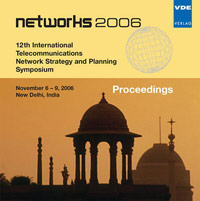IMS Operations Savings and Time to Market Improvements
Konferenz: networks 2006 - 12th International Telecommunications Network Strategy and Planning - Symposium
06.11.2006 - 09.11.2006 in New Delhi, India
Tagungsband: networks 2006
Seiten: 7Sprache: EnglischTyp: PDF
Persönliche VDE-Mitglieder erhalten auf diesen Artikel 10% Rabatt
Autoren:
Katkar, Vanita; Chu, Ming; Doherty, Deirdre; El-Sayed, Mohamed; Wu, Paul (Lucent Technologies – Bell Labs, 101 Crawfords Corner Rd., Holmdel, NJ 07733, USA)
Inhalt:
Service providers are often forced to deploy stand-alone, individual service applications (referred to as “point solutions”) to meet revenue pressures; and are faced with the complex and expensive task of integrating these solutions and associated operations after investing in the infrastructure. The IP Multimedia Subsystem (IMS) architecture is designed to provide an environment where applications can share common functions and interact seamlessly. The measure of succes s of an IMS infrastructure will depend on the service provider’s ability to quickly and costeffectively introduce and manage new revenue-generating applications. This paper describes the results of an analysis conducted to quantify and determine how applications/services deployed using an IMS infrastructure can reduce operations costs and improve “Time to Market (TTM)”. A detailed task-based operations cost model was developed for comparing IMS-based solutions with Point Solutions (PS) for a rollout of eight applications over three years. The model used the following: - Enhanced Telecom Operations MapÔ standard, - Operations Cost Analysis & Modeling methodology (developed by Bell Labs), - Total Operations Competence metrics (developed by Bell Labs), to identify and quantify the tasks associated with deployment and management of new applications. The IMSbased solution results were compared with a Point Solution approach, and were used to identify where the differences lay and quantify them. IMS-based solutions showed operations cost savings of approximately 20~25% overall, and a reduction of approximately 20% for Time to Market over the 5 year study period.


